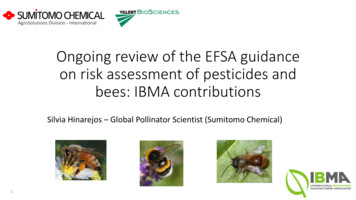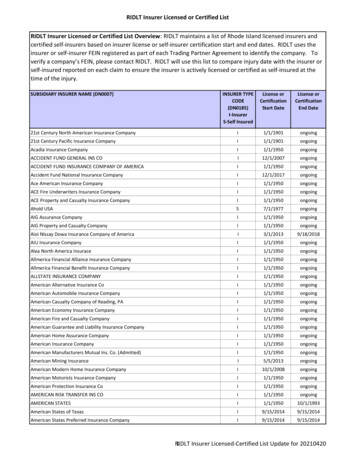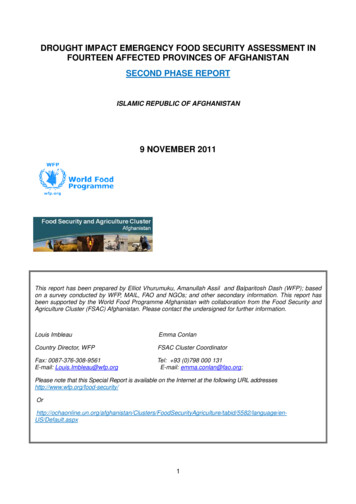
Transcription
AgroSolutions Division - InternationalOngoing review of the EFSA guidanceon risk assessment of pesticides andbees: IBMA contributionsSilvia Hinarejos – Global Pollinator Scientist (Sumitomo Chemical)1
2013 EFSA Bee Guidance In 2013, EFSA adopted the Guidance Document on the risk assessment of plantprotection products on bees (Apis mellifera, Bombus spp. and solitary bees) 3 groups of bee species: honey bees, bumble bees, solitary bees 3 application methods: spray, seed treatment, granules 3 exposure routes: contact, dietary, water 3 ( 1) risk cases: acute, chronic, larvae 5 scenarios: treated crop, in-field weeds, field margins, adjacent crop, next crop 3 ( 1) tiers2
Background However, 2013 EFSA guidance has not been fully implemented due tothe lack of consensus between Member States In March 2019 EFSA was mandated by European Commission toreview the guidance because: A majority of Member States requesting updates New scientific evidence has become available since 2013 EFSA committed to: Finalise the work (pending definitions of Protection Goals by the RiskManagers) in March 2021 Involve stakeholders and MSs throughout the process3
EFSA Stakeholder Consultation Group EFSA call for nominations ofstakeholder bee experts inMay 2019 17 applications received Based on the predefinedcriteria, 9 selected All the 9 organisations plusMSs are involved in EFSA adhoc consultations4
IBMA ad hoc expert groupExpert Members5ApisBen Jones (until March 2020)Biotecnologie BTMonica ColliCBC (Europe)Edith LadurnerIBMAUlf Heilig , Jennifer LewisIPM ImpactGuido SterkKoppertWillem RavensbergSumitomo ChemicalSilvia Hinarejos - IBMA’s expert in the EFSA SHsSuterraAlessandra Moccia
Progress of the review of the bee GD:overviewMarch2019 WG setting ad hoc SHgroup settingJune2019Sep 20191st Consultation of SHs and MSs on the(EFSA, 2013)Oct 20192ndConsultation of SHs and MSs on theprotocol for the background mortality1st Consultation of Risk Managers onSPGs : SPGs and trigger values in the EFSA(2013) Discussion and feedback Feb 2020Outline on procedural aspects/timelinesCollaborating with ECHAProject on background mortalityDevelopment of the protocol for ToR3 andToR4April2020Apr 20203rd Consultation/workshop with SHs and MSson the protocol for ToR3 and 4Implementation of the protocol for ToR3 andToR4: Perform the EKE for the attractiveness to pollenand nectar Systematic literature review for foodconsumption Systematic literature review for the sugarcontent in nectar Update of the residue database Relevance of exposure scenarios (weeds, water) etcOctober20203rd Consultation of RiskManagers on SPGsFinalisation of the GD(once SPG are defined): Revision of the triggervalues Revision of the highertier requirementsJun 20202nd Consultation of Risk Managers on SPGs: Development of the supportive document forRMs Implementation of the approach selected by RMsSHs: StakeholderConsultation Group6
Aspects of the Bee GD under Review (1/2) Review of the evidence on bee background mortality - Reportpublished 28 July 2020* Systematic literature review for food consumption (HB, BB and SB) Systematic literature review for the sugar content in nectar of variouscrops Expert Knowledge Elicitations (EKE) for the attractiveness to pollen&nectar - 6 experts selected Systematic revision of the available residue data in pollen&nectar Inter-species sensitivity analysis7* 0
Aspects of the Bee GD under Review (2/2) Analysis of dose-response (extensive review) useful for: Extrapolation factors Endpoints definition Trigger values Review of the relevance weed/water/succeeding crop scenarios Definition of default parameters included in the oral exposure model Mixture toxicity and risk assessment Risk assessment metabolites Consideration of sublethal effect, accumulative effect,recommendations for exposure refinement8
Other aspects to be reviewed afterthe SPG setting Revision of the higher tier requirements: to detect the derived threshold ofacceptable effects and how to assess theexposure Revision of the methodology for thetrigger values: to calibrate the lower tier risk assessmentand revise the trigger values9
IBMA: contributions relating tobiologicals&semiochemicals Considered part of the EFSA mandate to review the currentmethodology once the Risk Managers (MS) have decided the SPGs: In Risk Manager consultations/workshops on SPGs, 3 typical biologicalapplication types (1 generalist microbial, 1 specialist microbial and 1semiochemical dispenser) were concluded to have minimal negative impacton ecosystem services. Therefore, it would be valuable that EFSA includes scenarios specific formicrobial PPPs and semiochemicals which relate to the reduced impactalready established by Risk Managers.10
IBMA: contributions relating tobiologicals&semiochemicals Effect Assessment: EFSA refers to OECD guidelines, validated and suitable for chemical pesticides only Current practice for microbials is to use OCSPP (US) guidelines to assesspathogenicity/infectivity The differences between the OECD and OCSPP guidelines can lead to several issuesrendering the proposed bee risk assessment inappropriate We informed that the International Commission on Plant Pollinator Relations(ICPPR)-Microbial WG is producing for OECD a white paper on state-of-art ontesting methods for microbials, i.e. describing the available guidelines limitationsfor testing microbials.11
IBMA: contributions relating tobiologicals&semiochemicals Exposure Assessment: Current risk assessment practice for biologicals is more qualitative thanquantitative (as proposed by EFSA). Will be challenging to try to estimateexposure given their specificities If data are available, waivers should be still used if negligible or minimalexposure. Non-Apis bees: IBMA has members producing managed bumble bees and solitary bees forcommercial pollination. Knowledge and insights has been provided.12
IBMA: contributions relating tobiologicals&semiochemicals Overall, after 3 consultations, our conclusion is that biologicals andtheir specificities are not properly considered in the future EFSAguidance. Are there excluded?[question in the April 2020 workshop] According to EFSA feedback, the scope of the current review is forchemical pesticides13
Conclusive remarks & Next steps Regarding the overall EFSA progress: Due to the complexity of the project and the uncertainties caused by COVID19, the current deadline of March 2021 may change The scientific process for defining the SPGs for bees is driven by the ongoingparallel Risk Managers (MSs) discussions on what to protect and to whichextent, and the EFSA review depends on those decisions to progress To support the decision-making process by Risk Managers, EFSA identified 4methodological approaches (workshop organised by DG SANTE on 30 June). Making use of population models was the option preferred by MS A second preliminary report on how this approach is implemented by EFSA will beissued to Risk Managers for their 3rd consultation on SPGs (report will be published onthe EFSA website, SHs will be pre-notified)14
Conclusive remarks & Next steps Regarding the impact on IBMA: IBMA will keep reminding EFSA, to explicitly exclude biologicals, at leastmicrobials, in the final revised guidance. Unclear at this stage the impact on pheromones or botanicals, currently theEFSA guidance is applied for those. We will need further clarity by EFSA (andalso in other the discussions between IBMA and DG SANTE on datarequirements). We don’t expect new consultations of the SHs but should have theopportunity to comment on the draft new guidance before it is finalised.15
Thank You!Questions?Silvia Hinarejos – Sumitomo Chemical, Global Pollinator ScientistE-mail: silvia.hinarejos@sumitomo-chem.fr
Aspects of the Bee GD under Review (1/2) Review of the evidence on bee background mortality - Report published 28 July 2020* Systematic literature review for food consumption (HB, BB and SB) Systematic literature review for the sugar content in nectar of various crops Expert Knowledge Elicitations (EKE) for the attractiveness to pollen










